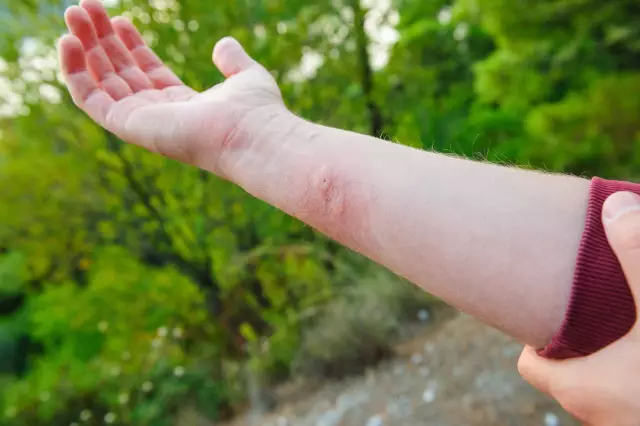- Author Rachel Wainwright [email protected].
- Public 2023-12-15 07:39.
- Last modified 2025-11-02 20:14.
Dyshidrosis

Dyshidrosis is a specific pathology of the skin that occurs when the ducts of the sweat glands are critically blocked. Dyshidrosis in each case can be classified as a separate disease or as a symptom of another skin disease. The most common forms of the disease are foot dyshidrosis and hand dyshidrosis. The etiology of this painful condition is still unknown.
Causes and symptoms of dyshidrosis
Dyshidrosis can manifest itself in the form of true dyshidrosis of the feet and hands, or in the form of dyshidrotic eczema.
With true dyshidrosis of the hands, bubbles appear on the palms. There is a clear liquid inside the bubbles. Bubbles with a dense membrane can remain on the skin for up to ten days. Almost all bubbles will shrink and disappear over time. New vesicles with true dyshidrosis do not form (unlike dyshidrotic eczema). The shell of individual bubbles can burst, and then all the liquid contained inside is poured out. At the site of the bursting bubble, surface erosion is usually formed. Erosion-affected areas of the skin develop itching and pain.
With hand dyshidrosis, bubbles usually appear on both the back and the inside of the hands.
Dyshidrotic eczema can manifest itself as a result of nervous shocks, stress, fear, excitement. The cause of the development of dyshidrotic eczema can be allergic reactions, disorders of the endocrine system, disturbances in the functioning of the nervous system. Swelling and slight redness appear on the skin, and then bubbles form. Bubbles appear on the skin in isolated groups. They contain serous fluid inside. The number of formations with dyshidrosis of the hands and feet in the form of eczema is constantly increasing. Dyshidrotic eczema is difficult to treat. It is dangerous with unexpected exacerbations. With an exacerbation, the body temperature rises to 38 ° C, the lymph nodes under the armpits and in the elbow area become inflamed and enlarged. The patient complains of burning and severe itching in the affected areas. The penetration of the vesicles of pathogenic microorganisms leads to the occurrence of various inflammatory processes. Inflammatory processes are usually accompanied by the release of purulent masses.
The development of dyshidrosis can occur from one week to several months.
Dyshidrosis treatment

Dyshidrosis treatment should be comprehensive. With this disease, a dermatologist can prescribe acupuncture, laser therapy, cryotherapy, magnetotherapy, electrosleep, electrophoresis or paraffin therapy.
The process of treating dyshidrosis involves the intake of anti-inflammatory, antihistamines and hyposensitizing drugs. In severe cases of the disease, the doctor may prescribe glucocorticosteroid drugs in conjunction with diuretics.
For small rashes, you can use various ointments containing sulfur, tar, naphthalan, as well as indifferent pastes and talkers. With exacerbation of skin rashes, lotions with a solution of Burov's liquid, ethacridine, amidopyrine, lactate and furacilin will help to alleviate the painful condition. If the vesicles become infected, consult a doctor immediately.
During the period of exacerbation of dyshidrosis of the feet and hands, one should refrain from water procedures using cosmetics and soap. It is also necessary to exclude contact of the affected areas with various chemicals, with rain, snow, sun, wind, as well as with fur, wool and synthetics.
With dyshidrosis of the feet and hands, it is very useful to take warm baths with herbal broth with celandine, chamomile, oak bark and sage. Such baths have a very soothing effect on the skin. They relieve itching and have a disinfectant effect. The baths should be taken daily for twenty minutes.
Treatment of dyshidrosis with folk remedies
Folk remedies for dyshidrosis help relieve inflammation and itching. Horseradish decoction will help to alleviate the condition of the skin. To prepare the broth, four teaspoons of grated horseradish are poured into 500 ml of boiling water and left to infuse for two hours, after which they are cooled. You can wipe the affected areas with a decoction of blackberry leaves. One hundred grams of chopped blackberry leaves are poured with two liters of boiling water and allowed to brew. The prepared broth is used to wipe the affected areas. Lemon infusion is perfect for lotions. The juice of one lemon is mixed with egg white. A teaspoon of glycerin and one hundred grams of any cologne are added to the resulting mixture. Everything is thoroughly mixed and applied to the affected areas.
With dyshidrosis, the places of rashes and redness can be lubricated with sea buckthorn oil several times a day.
You can lubricate the affected areas with blackcurrant ointment. 200 grams of butter are mixed with black currant branches crushed to powder. The resulting mixture is placed in a water bath for five minutes.
With dyshidrosis, you can make lotions with eucalyptus tincture. Four tablespoons are poured over 500 ml of boiling water, put on low heat, brought to a boil and boiled for about an hour over low heat. The resulting mixture is filtered and used in the form of lotions.
YouTube video related to the article:
The information is generalized and provided for informational purposes only. At the first sign of illness, see your doctor. Self-medication is hazardous to health!






